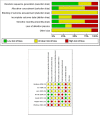Increased fruit and vegetable intake has no discernible effect on weight loss: a systematic review and meta-analysis
- PMID: 24965308
- PMCID: PMC4095660
- DOI: 10.3945/ajcn.114.090548
Increased fruit and vegetable intake has no discernible effect on weight loss: a systematic review and meta-analysis
Abstract
Background: A common dietary recommendation for weight loss, especially in lay public outlets, is to eat more fruit and vegetables (F/Vs). Without a compensatory reduction in total energy intake, significant weight loss would be unlikely.
Objective: We aimed to synthesize the best available evidence on the effectiveness of the general recommendation to eat more F/Vs for weight loss or the prevention of weight gain.
Design: We searched multiple databases for human randomized controlled trials that evaluated the effect of increased F/V intake on body weight. Inclusion criteria were as follows: ≥15 subjects/ treatment arm, ≥8-wk intervention, a stated primary or secondary outcome of body weight, the stated goal of the intervention was weight or fat loss or the prevention of weight or fat gain, and food intake provided or prescribed was of a variety of F/Vs that remained minimally processed.
Results: Two studies met all criteria; 5 other studies met all criteria but one. The primary analysis indicated an effect size of weight change (outcome of interest) from baseline [standardized mean difference (SMD) for studies that met all criteria] of -0.16 (95% CI: -0.78, 0.46) (P = 0.60). The SMD for 7 studies that met all or most criteria was 0.04 (95% CI: -0.10, 0.17) (P = 0.62).
Conclusions: Studies to date do not support the proposition that recommendations to increase F/V intake or the home delivery or provision of F/Vs will cause weight loss. On the basis of the current evidence, recommending increased F/V consumption to treat or prevent obesity without explicitly combining this approach with efforts to reduce intake of other energy sources is unwarranted. This systematic review and meta-analysis was registered at http://www.crd.york.ac.uk/PROSPERO/ as CRD42013004688.
© 2014 American Society for Nutrition.
Figures




References
-
- Zelman K. 15 Best diet tips ever. Available from: http://www.webmd.com/diet/features/15-best-diet-tips-ever (cited 21 March 2014).
-
- WHO/FAO. Diet, nutrition and the prevention of chronic diseases: report of a Joint WHO/FAO Expert Consultation. Geneva, Switzerland: World Health Organization, 2003. Available from: http://whqlibdoc.who.int/trs/WHO_TRS_916.pdf (cited 21 March 2014).
-
- World Health Association. Global strategy on diet, physical activity and health - promoting fruit and vegetable consumption around the world. 2013. Available from: http://www.who.int/dietphysicalactivity/fruit/en/ (cited 21 March 2014).
-
- United States Department of Agriculture & United States Department of Health and Human Services. Dietary guidelines for Americans, 2010. Available from: http://health.gov/dietaryguidelines/2010.asp. (cited 21 March 2014).
-
- United States Department of Agriculture. 2013. Choose my plate. Available from: http://www.choosemyplate.gov/ (cited 21 March 2013).
Publication types
MeSH terms
Grants and funding
LinkOut - more resources
Full Text Sources
Other Literature Sources
Medical
Miscellaneous

